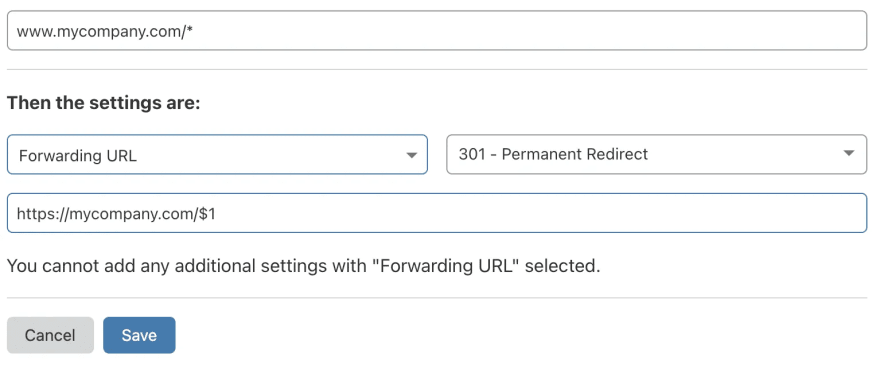Below is a quick overview of common scenarios where you may need to redirect visitors to another domain/url and how you can implement such redirection with Cloudflare.
The answer to all of the scenarios is either Page Rules or Workers. Note both require the domain where you forward from to be proxied by Cloudflare (orange cloud enabled on the DNS tab).
You can have up to 3 page rules and process up to 100k requests/day with the Cloudflare Free plan.
Redirect all traffic for source.com to target.com
Make sure there's a proxied DNS record for the root @ on the DNS tab of source.com. If missing, create one. Target can be anything, since forwarding page rule will execute before target is evaluated.
Create the redirect page rule. Set relevant HTTP redirection code:
-
302if it's a temporary setup and source.com will start serving traffic directly in future -
301if forwarding is permanent and you expect source domain to be always used to redirect visitors
What if you want to preserve the path during forwarding, i.e. source.com/login must redirect to target.com/login?
In the Destination URL field of the page rule, append $1 (value matched from the source), so that it reads https://target.com/$1.
Redirect non-www to www
Redirect www to non-www
Redirect specific path to a URL
You may want to make a nice short link at your root domain forwarding to some file you want to share.
Consider mycompany.com/deck pointing to a downloadable pdf file to share with investors.
Redirect paths to subdomains
Let's say there's a requirement to redirect country/locale codes in in paths to subdomains:
https://mycompany.com/fr → https://fr.mycompany.com
https://mycompany.com/de/some-page → https://de.mycompany.com/some-page
...
but https://mycompany.com/en → https://mycompany.com
Page rules is not flexible enough to handle this scenario. Cloudflare Workers to the rescue!
Go to the Workers tab → Manage Workers → Create a Worker
Create a basic worker that will parse the path, see if it's a country code, rewrite and redirect the URL if needed.
const redirectHttpCode = 301
addEventListener('fetch', event => {
event.respondWith(handleRequest(event.request))
})
/**
* Respond to the request
* @param {Request} request
*/
async function handleRequest(request) {
const url = new URL(request.url)
const { pathname } = url
const pathParts = pathname.split('/')
const pathPrefix = pathParts[1]
if (pathPrefix.length === 2) { // country code, you may want to do an inclusion check instead
if (pathPrefix !== 'en') {
url.host = `${pathPrefix}.${url.host}` // prepend subdomain
}
pathParts.splice(1, 1) // remove country code from path
url.pathname = pathParts.join('/')
return Response.redirect(url.toString(), redirectHttpCode)
}
return fetch(request) // by default proxy request as usual
}
Go back to the Workers tab → Add route.
Set Route to mycompany.com/*. Select the worker you created in previous step. Save.
In less than a minute, you can confirm forwarding scenarios work as expected.
...
Forwarding URL page rule covers basic use cases. If you need to apply custom logic with advanced mapping and url replacements, Cloudflare Workers should be used instead.
If you like this type of content you can follow me on Twitter for the latest updates.











Top comments (0)